jump start SKODA FABIA 2004 1.G / 6Y Owner's Manual
[x] Cancel search | Manufacturer: SKODA, Model Year: 2004, Model line: FABIA, Model: SKODA FABIA 2004 1.G / 6YPages: 247
Page 7 of 247
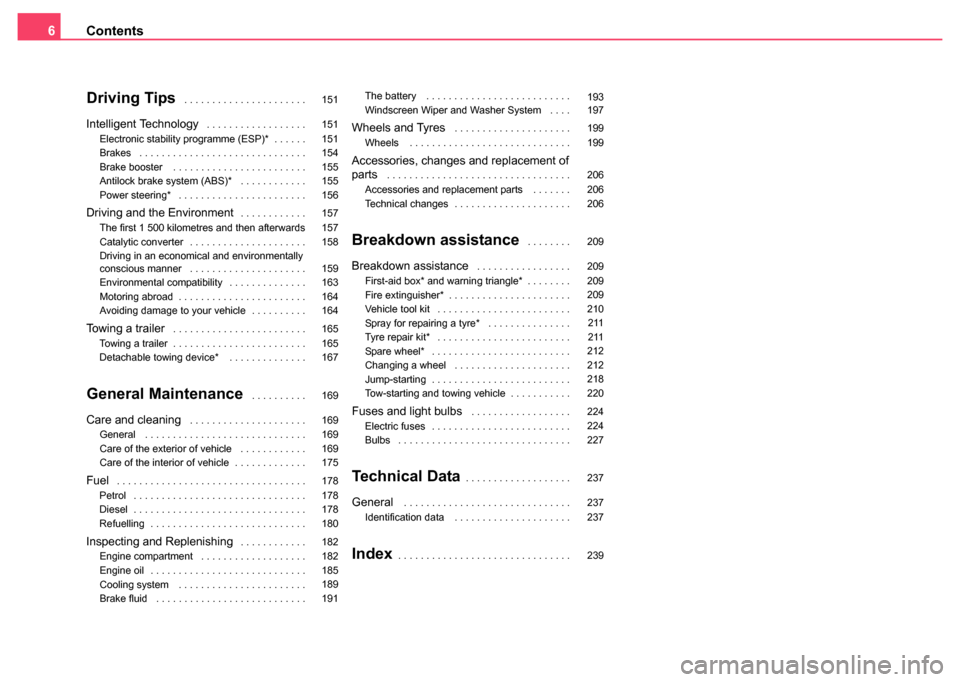
Contents
6
Driving Tips . . . . . . . . . . . . . . . . . . . . . .
Intelligent Technology . . . . . . . . . . . . . . . . . .
Electronic stability programme (ESP)* . . . . . .
Brakes . . . . . . . . . . . . . . . . . . . . . . . . . . . . . .
Brake booster . . . . . . . . . . . . . . . . . . . . . . . .
Antilock brake system (ABS)* . . . . . . . . . . . .
Power steering* . . . . . . . . . . . . . . . . . . . . . . .
Driving and the Environment. . . . . . . . . . . .
The first 1 500 kilometres and then afterwards
Catalytic converter . . . . . . . . . . . . . . . . . . . . .
Driving in an economical and environmentally
conscious manner . . . . . . . . . . . . . . . . . . . . .
Environmental compatibility . . . . . . . . . . . . . .
Motoring abroad . . . . . . . . . . . . . . . . . . . . . . .
Avoiding damage to your vehicle . . . . . . . . . .
Towing a trailer . . . . . . . . . . . . . . . . . . . . . . . .
Towing a trailer . . . . . . . . . . . . . . . . . . . . . . . .
Detachable towing device* . . . . . . . . . . . . . .
General Maintenance . . . . . . . . . .
Care and cleaning . . . . . . . . . . . . . . . . . . . . .
General . . . . . . . . . . . . . . . . . . . . . . . . . . . . .
Care of the exterior of vehicle . . . . . . . . . . . .
Care of the interior of vehicle . . . . . . . . . . . . .
Fuel. . . . . . . . . . . . . . . . . . . . . . . . . . . . . . . . . .
Petrol . . . . . . . . . . . . . . . . . . . . . . . . . . . . . . .
Diesel . . . . . . . . . . . . . . . . . . . . . . . . . . . . . . .
Refuelling . . . . . . . . . . . . . . . . . . . . . . . . . . . .
Inspecting and Replenishing. . . . . . . . . . . .
Engine compartment . . . . . . . . . . . . . . . . . . .
Engine oil . . . . . . . . . . . . . . . . . . . . . . . . . . . .
Cooling system . . . . . . . . . . . . . . . . . . . . . . .
Brake fluid . . . . . . . . . . . . . . . . . . . . . . . . . . . The battery . . . . . . . . . . . . . . . . . . . . . . . . . .
Windscreen Wiper and Washer System . . . .
Wheels and Tyres . . . . . . . . . . . . . . . . . . . . .
Wheels . . . . . . . . . . . . . . . . . . . . . . . . . . . . .
Accessories, changes and replacement of
parts . . . . . . . . . . . . . . . . . . . . . . . . . . . . . . . . .
Accessories and replacement parts . . . . . . .
Technical changes . . . . . . . . . . . . . . . . . . . . .
Breakdown assistance . . . . . . . .
Breakdown assistance . . . . . . . . . . . . . . . . .
First-aid box* and warning triangle* . . . . . . . .
Fire extinguisher* . . . . . . . . . . . . . . . . . . . . . .
Vehicle tool kit . . . . . . . . . . . . . . . . . . . . . . . .
Spray for repairing a tyre* . . . . . . . . . . . . . . .
Tyre repair kit* . . . . . . . . . . . . . . . . . . . . . . . .
Spare wheel* . . . . . . . . . . . . . . . . . . . . . . . . .
Changing a wheel . . . . . . . . . . . . . . . . . . . . .
Jump-starting . . . . . . . . . . . . . . . . . . . . . . . . .
Tow-starting and towing vehicle . . . . . . . . . . .
Fuses and light bulbs . . . . . . . . . . . . . . . . . .
Electric fuses . . . . . . . . . . . . . . . . . . . . . . . . .
Bulbs . . . . . . . . . . . . . . . . . . . . . . . . . . . . . . .
Technical Data. . . . . . . . . . . . . . . . . . .
General . . . . . . . . . . . . . . . . . . . . . . . . . . . . . .
Identification data . . . . . . . . . . . . . . . . . . . . .
Index. . . . . . . . . . . . . . . . . . . . . . . . . . . . . . .
151
151
151
154
155
155
156
157
157
158
159
163
164
164
165
165
167
169
169
169
169
175
178
178
178
180
182
182
185
189
191 193
197
199
199
206
206
206
209
209
209
209
210
211
211
212
212
218
220
224
224
227
237
237
237
239
Page 103 of 247
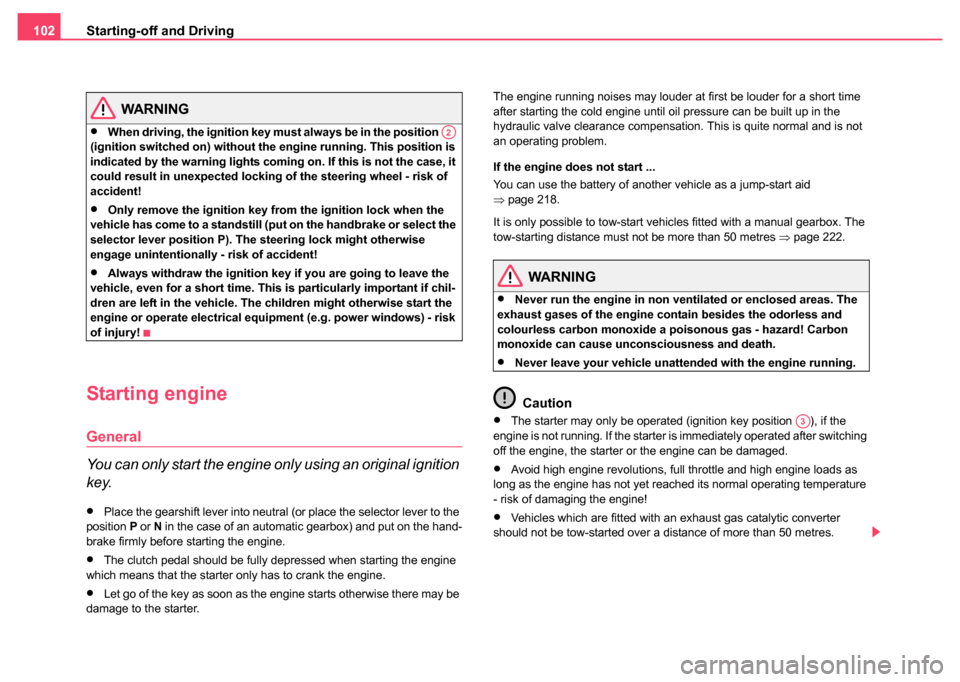
Starting-off and Driving
102
WARNING
•When driving, the ignition key must always be in the position
(ignition switched on) without the engine running. This position is
indicated by the warning lights coming on. If this is not the case, it
could result in unexpected locking of the steering wheel - risk of
accident!
•Only remove the ignition key fr om the ignition lock when the
vehicle has come to a standstill (put on the handbrake or select the
selector lever position P). The steering lock might otherwise
engage unintentionally - risk of accident!
•Always withdraw the ignition key if you are going to leave the
vehicle, even for a short time. This is particularly important if chil-
dren are left in the vehicle. The children might otherwise start the
engine or operate electrical equi pment (e.g. power windows) - risk
of injury!
Starting engine
General
You can only start the engine only using an original ignition
key.
•Place the gearshift lever into neutral (or place the selector lever to the
position P or N in the case of an automatic gearbox) and put on the hand-
brake firmly before starting the engine.
•The clutch pedal should be fully depressed when starting the engine
which means that the starter only has to crank the engine.
•Let go of the key as soon as the engine starts otherwise there may be
damage to the starter. The engine running noises may louder at first be louder for a short time
after starting the cold engine until oil pressure can be built up in the
hydraulic valve clearance compensation. This is quite normal and is not
an operating problem.
If the engine does not start ...
You can use the battery of another vehicle as a jump-start aid
⇒
page 218.
It is only possible to tow-start vehicles fitted with a manual gearbox. The
tow-starting distance must not be more than 50 metres ⇒page 222.
WARNING
•Never run the engine in non ventilated or enclosed areas. The
exhaust gases of the engine contain besides the odorless and
colourless carbon monoxide a poisonous gas - hazard! Carbon
monoxide can cause unconsciousness and death.
•Never leave your vehicle unattended with the engine running.
Caution
•The starter may only be operated (ignition key position ), if the
engine is not running. If the starter is immediately operated after switching
off the engine, the starter or the engine can be damaged.
•Avoid high engine revolutions, full throttle and high engine loads as
long as the engine has not yet reached its normal operating temperature
- risk of damaging the engine!
•Vehicles which are fitted with an exhaust gas catalytic converter
should not be tow-started over a distance of more than 50 metres.
A2
A3
Page 115 of 247
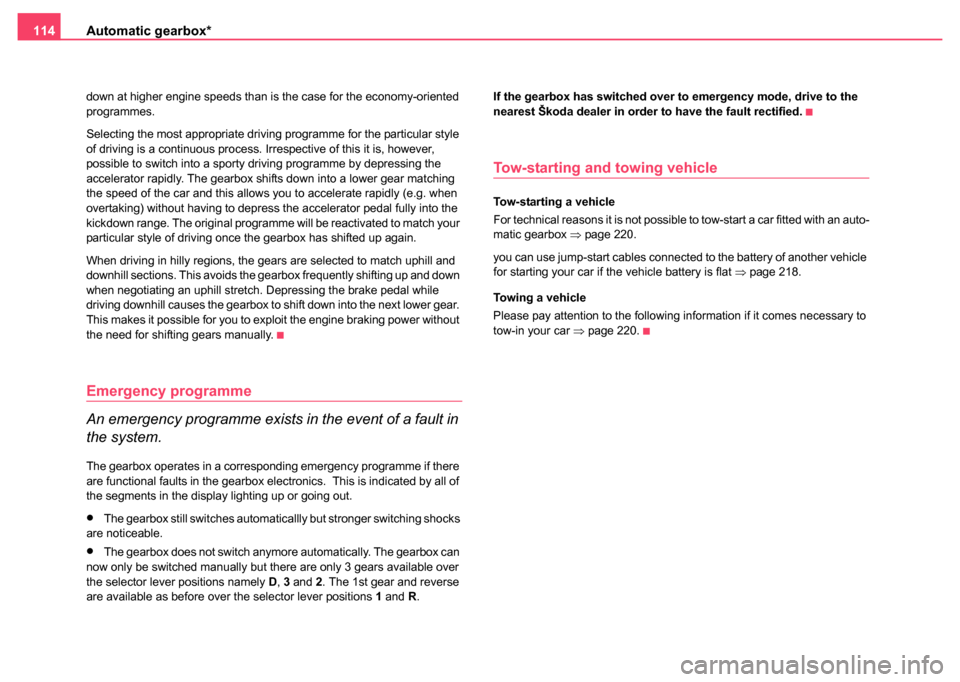
Automatic gearbox*
114
down at higher engine speeds than is the case for the economy-oriented
programmes.
Selecting the most appropriate driving programme for the particular style
of driving is a continuous process. Irrespective of this it is, however,
possible to switch into a sporty driving programme by depressing the
accelerator rapidly. The gearbox shifts down into a lower gear matching
the speed of the car and this allows you to accelerate rapidly (e.g. when
overtaking) without having to depress the accelerator pedal fully into the
kickdown range. The original programme will be reactivated to match your
particular style of driving once the gearbox has shifted up again.
When driving in hilly regions, the gears are selected to match uphill and
downhill sections. This avoids the gearbox frequently shifting up and down
when negotiating an uphill stretch. Depressing the brake pedal while
driving downhill causes the gearbox to shift down into the next lower gear.
This makes it possible for you to exploit the engine braking power without
the need for shifting gears manually.
Emergency programme
An emergency programme exists in the event of a fault in
the system.
The gearbox operates in a corresponding emergency programme if there
are functional faults in the gearbox electronics. This is indicated by all of
the segments in the display lighting up or going out.
•The gearbox still switches automaticallly but stronger switching shocks
are noticeable.
•The gearbox does not switch anymore automatically. The gearbox can
now only be switched manually but there are only 3 gears available over
the selector lever positions namely D, 3 and 2. The 1st gear and reverse
are available as before over the selector lever positions 1 and R. If the gearbox has switched over to emergency mode, drive to the
nearest Škoda dealer in order to have the fault rectified.
Tow-starting and towing vehicle
Tow-starting a vehicle
For technical reasons it is not possible to tow-start a car fitted with an auto-
matic gearbox
⇒page 220.
you can use jump-start cables connected to the battery of another vehicle
for starting your car if the vehicle battery is flat ⇒page 218.
Towing a vehicle
Please pay attention to the following information if it comes necessary to
tow-in your car ⇒page 220.
Page 157 of 247
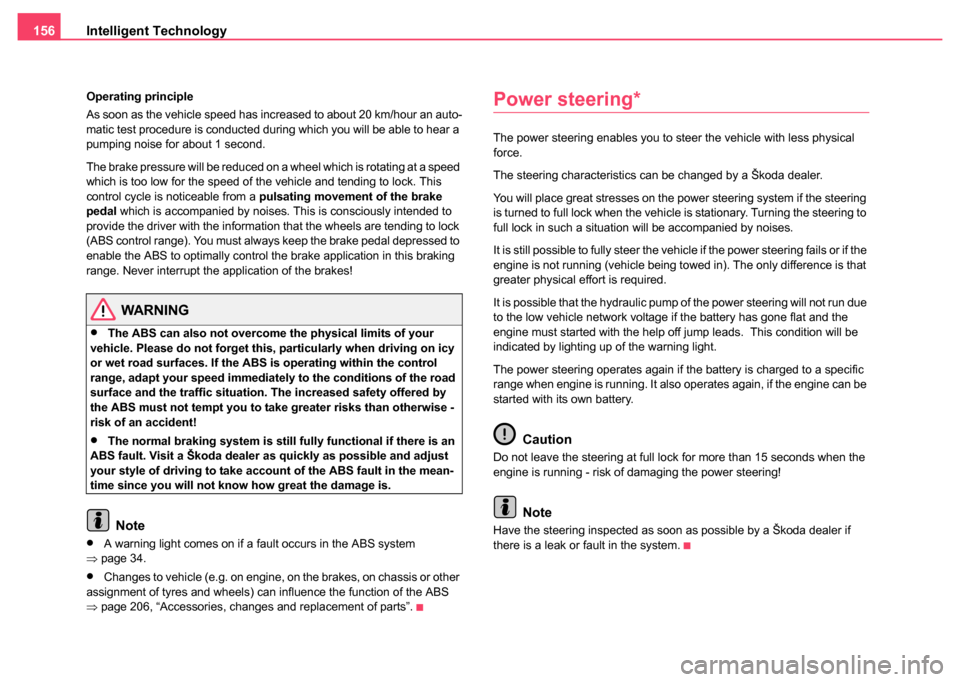
Intelligent Technology
156
Operating principle
As soon as the vehicle speed has increased to about 20 km/hour an auto-
matic test procedure is conducted during which you will be able to hear a
pumping noise for about 1 second.
The brake pressure will be reduced on a wheel which is rotating at a speed
which is too low for the speed of the vehicle and tending to lock. This
control cycle is noticeable from a pulsating movement of the brake
pedal which is accompanied by noises. This is consciously intended to
provide the driver with the information that the wheels are tending to lock
(ABS control range). You must always keep the brake pedal depressed to
enable the ABS to optimally control the brake application in this braking
range. Never interrupt the application of the brakes!
WARNING
•The ABS can also not overcome the physical limits of your
vehicle. Please do not forget this, particularly when driving on icy
or wet road surfaces. If the ABS is operating within the control
range, adapt your speed immediately to the conditions of the road
surface and the traffic situation. The increased safety offered by
the ABS must not tempt you to take greater risks than otherwise -
risk of an accident!
•The normal braking system is still fully functional if there is an
ABS fault. Visit a Škoda dealer as quickly as possible and adjust
your style of driving to take account of the ABS fault in the mean-
time since you will not know how great the damage is.
Note
•A warning light comes on if a fault occurs in the ABS system
⇒ page 34.
•Changes to vehicle (e.g. on engine, on the brakes, on chassis or other
assignment of tyres and wheels) can influence the function of the ABS
⇒ page 206, “Accessories, changes and replacement of parts”.
Power steering*
The power steering enables you to steer the vehicle with less physical
force.
The steering characteristics can be changed by a Škoda dealer.
You will place great stresses on the power steering system if the steering
is turned to full lock when the vehicle is stationary. Turning the steering to
full lock in such a situation will be accompanied by noises.
It is still possible to fully steer the vehicle if the power steering fails or if the
engine is not running (vehicle being towed in). The only difference is that
greater physical effort is required.
It is possible that the hydraulic pump of the power steering will not run due
to the low vehicle network voltage if the battery has gone flat and the
engine must started with the help off jump leads. This condition will be
indicated by lighting up of the warning light.
The power steering operates again if the battery is charged to a specific
range when engine is running. It also operates again, if the engine can be
started with its own battery.
Caution
Do not leave the steering at full lock for more than 15 seconds when the
engine is running - risk of damaging the power steering!
Note
Have the steering inspected as soon as possible by a Škoda dealer if
there is a leak or fault in the system.
Page 219 of 247
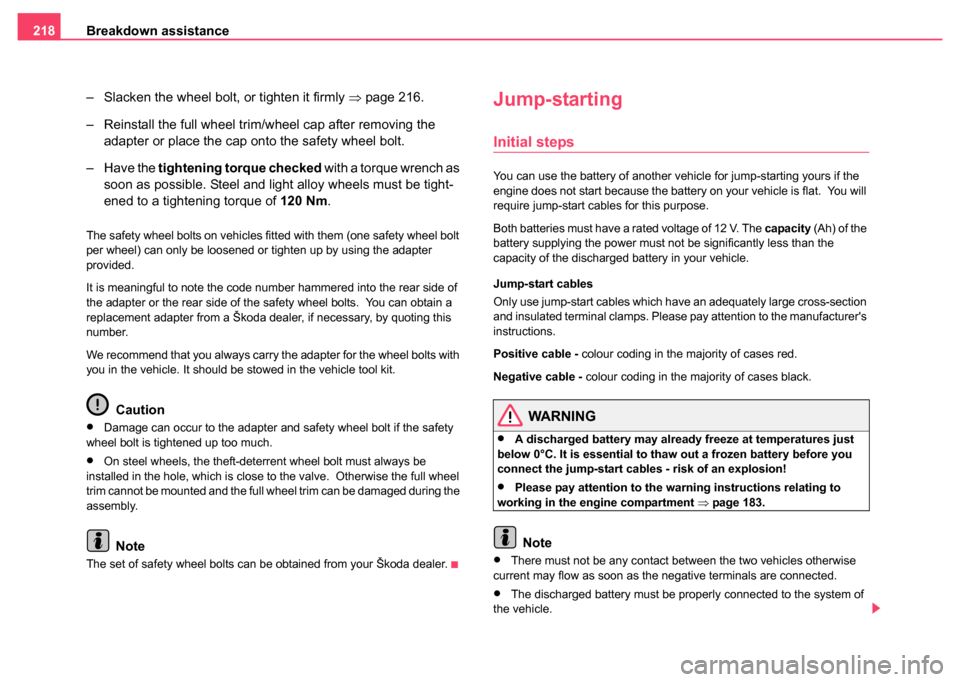
Breakdown assistance
218
– Slacken the wheel bolt, or tighten it firmly ⇒page 216.
– Reinstall the full wheel trim/wheel cap after removing the adapter or place the cap onto the safety wheel bolt.
– Have the tightening torque checked with a torque wrench as
soon as possible. Steel and light alloy wheels must be tight-
ened to a tightening torque of 120 Nm.
The safety wheel bolts on vehicles fitted with them (one safety wheel bolt
per wheel) can only be loosened or tighten up by using the adapter
provided.
It is meaningful to note the code number hammered into the rear side of
the adapter or the rear side of the safety wheel bolts. You can obtain a
replacement adapter from a Škoda dealer, if necessary, by quoting this
number.
We recommend that you always carry the adapter for the wheel bolts with
you in the vehicle. It should be stowed in the vehicle tool kit.
Caution
•Damage can occur to the adapter and safety wheel bolt if the safety
wheel bolt is tightened up too much.
•On steel wheels, the theft-deterrent wheel bolt must always be
installed in the hole, which is close to the valve. Otherwise the full wheel
trim cannot be mounted and the full wheel trim can be damaged during the
assembly.
Note
The set of safety wheel bolts can be obtained from your Škoda dealer.
Jump-starting
Initial steps
You can use the battery of another vehicle for jump-starting yours if the
engine does not start because the battery on your vehicle is flat. You will
require jump-start cables for this purpose.
Both batteries must have a rated voltage of 12 V. The capacity (Ah) of the
battery supplying the power must not be significantly less than the
capacity of the discharged battery in your vehicle.
Jump-start cables
Only use jump-start cables which have an adequately large cross-section
and insulated terminal clamps. Please pay attention to the manufacturer's
instructions.
Positive cable - colour coding in the majority of cases red.
Negative cable - colour coding in the majority of cases black.
WARNING
•A discharged battery may already freeze at temperatures just
below 0°C. It is essential to thaw out a frozen battery before you
connect the jump-start cables - risk of an explosion!
•Please pay attention to the warning instructions relating to
working in the engine compartment ⇒page 183.
Note
•There must not be any contact between the two vehicles otherwise
current may flow as soon as the negative terminals are connected.
•The discharged battery must be properly connected to the system of
the vehicle.
Page 220 of 247
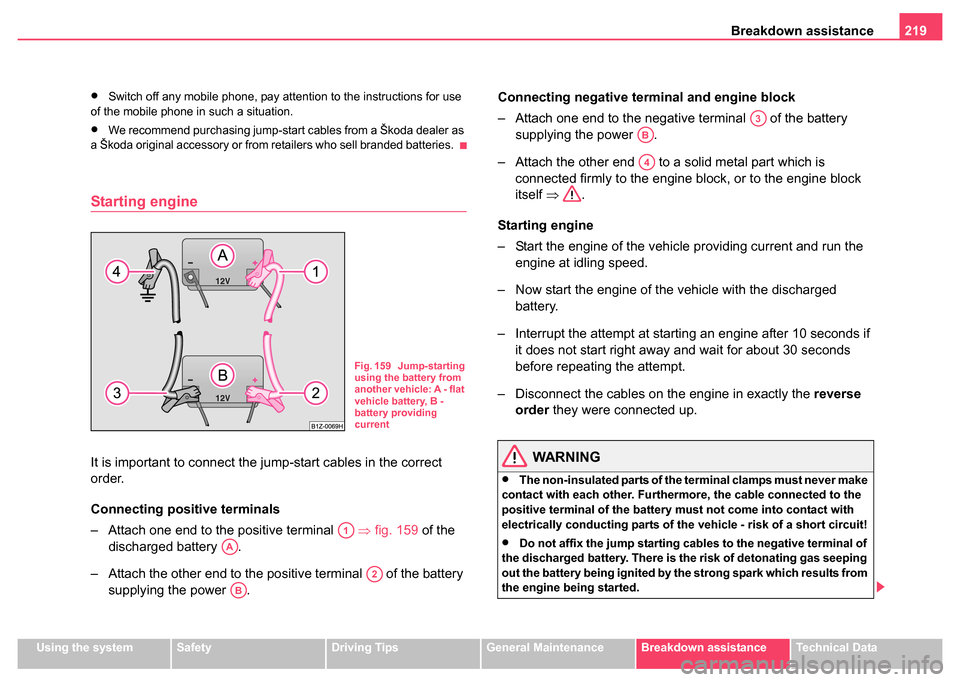
Breakdown assistance219
Using the systemSafetyDriving TipsGeneral MaintenanceBreakdown assistanceTechnical Data
•Switch off any mobile phone, pay attention to the instructions for use
of the mobile phone in such a situation.
•We recommend purchasing jump-start cables from a Škoda dealer as
a Škoda original accessory or from retailers who sell branded batteries.
Starting engine
It is important to connect the jump-start cables in the correct
order.
Connecting positive terminals
– Attach one end to the positive terminal ⇒fig. 159 of the
discharged battery .
– Attach the other end to the positive terminal of the battery supplying the power . Connecting negative terminal and engine block
– Attach one end to the negative terminal of the battery
supplying the power .
– Attach the other end to a solid metal part which is connected firmly to the engine block, or to the engine block
itself ⇒ .
Starting engine
– Start the engine of the vehicle providing current and run the engine at idling speed.
– Now start the engine of the vehicle with the discharged battery.
– Interrupt the attempt at starting an engine after 10 seconds if it does not start right away and wait for about 30 seconds
before repeating the attempt.
– Disconnect the cables on the engine in exactly the reverse
order they were connected up.WARNING
•The non-insulated parts of the terminal clamps must never make
contact with each other. Furthermore, the cable connected to the
positive terminal of the battery must not come into contact with
electrically conducting parts of the vehicle - risk of a short circuit!
•Do not affix the jump starting cables to the negative terminal of
the discharged battery. There is the risk of detonating gas seeping
out the battery being ignited by the strong spark which results from
the engine being started.
Fig. 159 Jump-starting
using the battery from
another vehicle: A - flat
vehicle battery, B -
battery providing
current
A1
AA
A2
AB
A3
AB
A4
Page 221 of 247
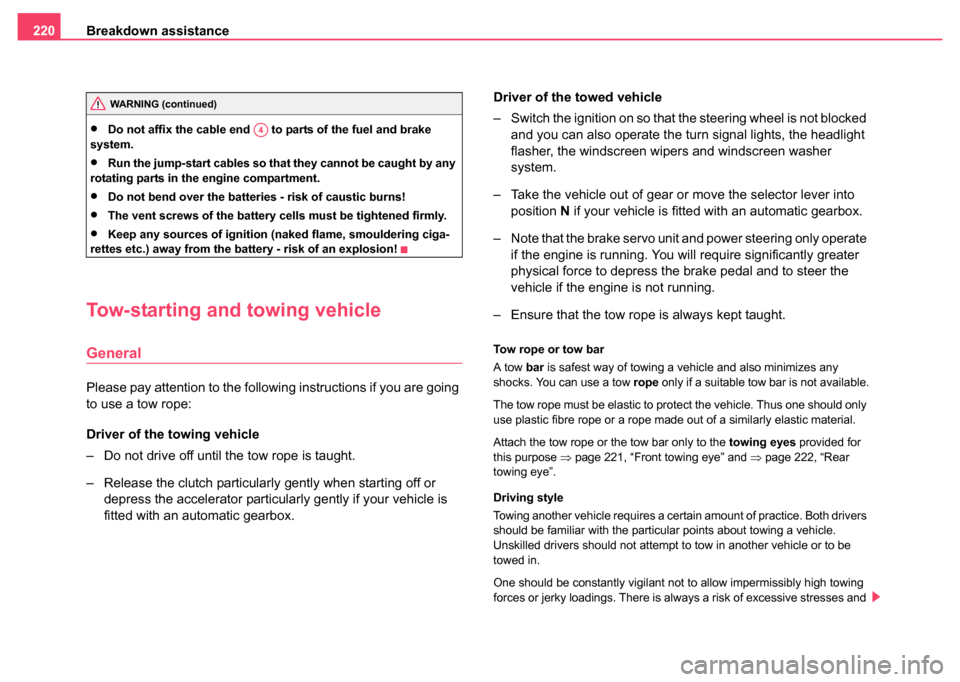
Breakdown assistance
220
•Do not affix the cable end to parts of the fuel and brake
system.
•Run the jump-start cables so that they cannot be caught by any
rotating parts in the engine compartment.
•Do not bend over the batteries - risk of caustic burns!
•The vent screws of the battery cells must be tightened firmly.
•Keep any sources of ignition (naked flame, smouldering ciga-
rettes etc.) away from the battery - risk of an explosion!
Tow-starting and towing vehicle
General
Please pay attention to the following instructions if you are going
to use a tow rope:
Driver of the towing vehicle
– Do not drive off until the tow rope is taught.
– Release the clutch particularly gently when starting off or depress the accelerator particularly gently if your vehicle is
fitted with an automatic gearbox. Driver of the towed vehicle
– Switch the ignition on so that the steering wheel is not blocked
and you can also operate the turn signal lights, the headlight
flasher, the windscreen wipers and windscreen washer
system.
– Take the vehicle out of gear or move the selector lever into position N if your vehicle is fitted with an automatic gearbox.
– Note that the brake servo unit and power steering only operate if the engine is running. You will require significantly greater
physical force to depress the brake pedal and to steer the
vehicle if the engine is not running.
– Ensure that the tow rope is always kept taught.
Tow rope or tow bar
A tow bar is safest way of towing a vehicle and also minimizes any
shocks. You can use a tow rope only if a suitable tow bar is not available.
The tow rope must be elastic to protect the vehicle. Thus one should only
use plastic fibre rope or a rope made out of a similarly elastic material.
Attach the tow rope or the tow bar only to the towing eyes provided for
this purpose ⇒ page 221, “Front towing eye” and ⇒page 222, “Rear
towing eye”.
Driving style
Towing another vehicle requires a certain amount of practice. Both drivers
should be familiar with the particular points about towing a vehicle.
Unskilled drivers should not attempt to tow in another vehicle or to be
towed in.
One should be constantly vigilant not to allow impermissibly high towing
forces or jerky loadings. There is always a risk of excessive stresses and
WARNING (continued)
A4
Page 223 of 247
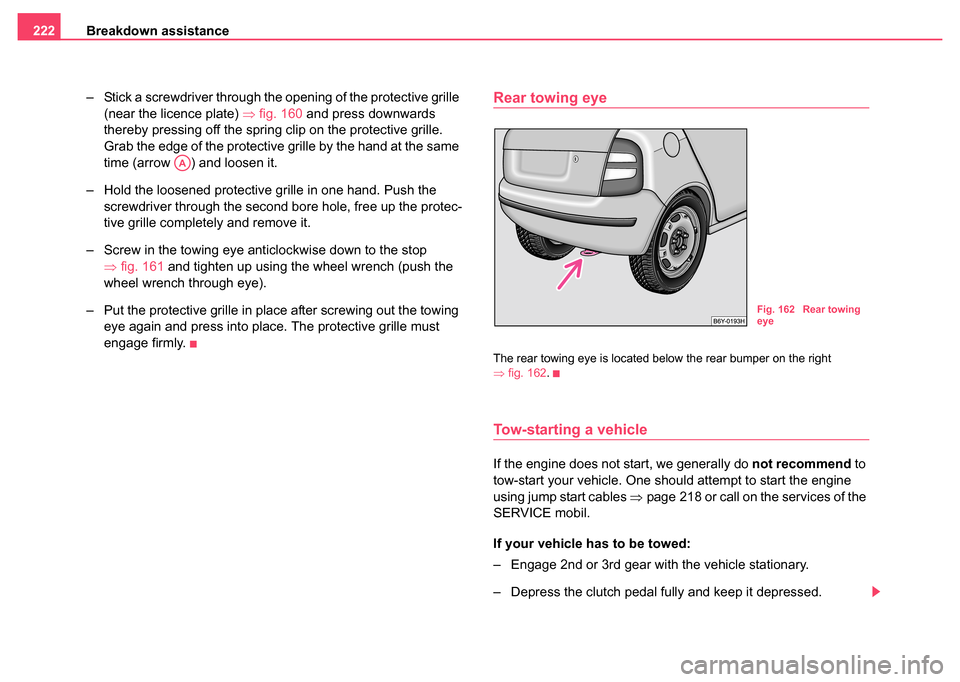
Breakdown assistance
222
– Stick a screwdriver through the opening of the protective grille (near the licence plate) ⇒fig. 160 and press downwards
thereby pressing off the spring clip on the protective grille.
Grab the edge of the protective grille by the hand at the same
time (arrow ) and loosen it.
– Hold the loosened protective grille in one hand. Push the screwdriver through the second bore hole, free up the protec-
tive grille completely and remove it.
– Screw in the towing eye anticlockwise down to the stop ⇒fig. 161 and tighten up using the wheel wrench (push the
wheel wrench through eye).
– Put the protective grille in place after screwing out the towing eye again and press into place. The protective grille must
engage firmly.
Rear towing eye
The rear towing eye is located below the rear bumper on the right
⇒fig. 162 .
Tow-starting a vehicle
If the engine does not start, we generally do not recommend to
tow-start your vehicle. One should attempt to start the engine
using jump start cables ⇒page 218 or call on the services of the
SERVICE mobil.
If your vehicle has to be towed:
– Engage 2nd or 3rd gear with the vehicle stationary.
– Depress the clutch pedal fully and keep it depressed.
AA
Fig. 162 Rear towing
eye
Page 242 of 247
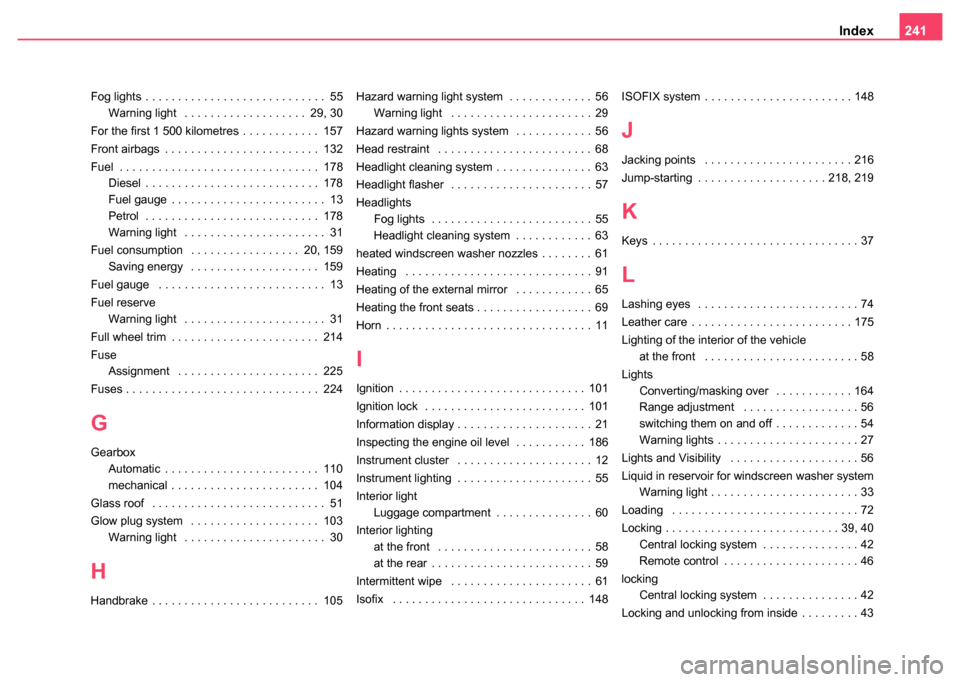
Index241
Fog lights . . . . . . . . . . . . . . . . . . . . . . . . . . . . 55
Warning light . . . . . . . . . . . . . . . . . . . 29, 30
For the first 1 500 kilometres . . . . . . . . . . . . 157
Front airbags . . . . . . . . . . . . . . . . . . . . . . . . 132
Fuel . . . . . . . . . . . . . . . . . . . . . . . . . . . . . . . 178 Diesel . . . . . . . . . . . . . . . . . . . . . . . . . . . 178
Fuel gauge . . . . . . . . . . . . . . . . . . . . . . . . 13
Petrol . . . . . . . . . . . . . . . . . . . . . . . . . . . 178
Warning light . . . . . . . . . . . . . . . . . . . . . . 31
Fuel consumption . . . . . . . . . . . . . . . . . 20, 159 Saving energy . . . . . . . . . . . . . . . . . . . . 159
Fuel gauge . . . . . . . . . . . . . . . . . . . . . . . . . . 13
Fuel reserve Warning light . . . . . . . . . . . . . . . . . . . . . . 31
Full wheel trim . . . . . . . . . . . . . . . . . . . . . . . 214
Fuse Assignment . . . . . . . . . . . . . . . . . . . . . . 225
Fuses . . . . . . . . . . . . . . . . . . . . . . . . . . . . . . 224
G
Gearbox Automatic . . . . . . . . . . . . . . . . . . . . . . . . 110
mechanical . . . . . . . . . . . . . . . . . . . . . . . 104
Glass roof . . . . . . . . . . . . . . . . . . . . . . . . . . . 51
Glow plug system . . . . . . . . . . . . . . . . . . . . 103 Warning light . . . . . . . . . . . . . . . . . . . . . . 30
H
Handbrake . . . . . . . . . . . . . . . . . . . . . . . . . . 105 Hazard warning light system . . . . . . . . . . . . . 56
Warning light . . . . . . . . . . . . . . . . . . . . . . 29
Hazard warning lights system . . . . . . . . . . . . 56
Head restraint . . . . . . . . . . . . . . . . . . . . . . . . 68
Headlight cleaning system . . . . . . . . . . . . . . . 63
Headlight flasher . . . . . . . . . . . . . . . . . . . . . . 57
Headlights Fog lights . . . . . . . . . . . . . . . . . . . . . . . . . 55
Headlight cleaning system . . . . . . . . . . . . 63
heated windscreen washer nozzles . . . . . . . . 61
Heating . . . . . . . . . . . . . . . . . . . . . . . . . . . . . 91
Heating of the external mirror . . . . . . . . . . . . 65
Heating the front seats . . . . . . . . . . . . . . . . . . 69
Horn . . . . . . . . . . . . . . . . . . . . . . . . . . . . . . . . 11
I
Ignition . . . . . . . . . . . . . . . . . . . . . . . . . . . . . 101
Ignition lock . . . . . . . . . . . . . . . . . . . . . . . . . 101
Information display . . . . . . . . . . . . . . . . . . . . . 21
Inspecting the engine oil level . . . . . . . . . . . 186
Instrument cluster . . . . . . . . . . . . . . . . . . . . . 12
Instrument lighting . . . . . . . . . . . . . . . . . . . . . 55
Interior light Luggage compartment . . . . . . . . . . . . . . . 60
Interior lighting at the front . . . . . . . . . . . . . . . . . . . . . . . . 58
at the rear . . . . . . . . . . . . . . . . . . . . . . . . . 59
Intermittent wipe . . . . . . . . . . . . . . . . . . . . . . 61
Isofix . . . . . . . . . . . . . . . . . . . . . . . . . . . . . . 148 ISOFIX system . . . . . . . . . . . . . . . . . . . . . . . 148
J
Jacking points . . . . . . . . . . . . . . . . . . . . . . . 216
Jump-starting . . . . . . . . . . . . . . . . . . . . 218, 219
K
Keys . . . . . . . . . . . . . . . . . . . . . . . . . . . . . . . . 37
L
Lashing eyes . . . . . . . . . . . . . . . . . . . . . . . . . 74
Leather care . . . . . . . . . . . . . . . . . . . . . . . . . 175
Lighting of the interior of the vehicle
at the front . . . . . . . . . . . . . . . . . . . . . . . . 58
Lights Converting/masking over . . . . . . . . . . . . 164
Range adjustment . . . . . . . . . . . . . . . . . . 56
switching them on and off . . . . . . . . . . . . . 54
Warning lights . . . . . . . . . . . . . . . . . . . . . . 27
Lights and Visibility . . . . . . . . . . . . . . . . . . . . 56
Liquid in reservoir for windscreen washer system Warning light . . . . . . . . . . . . . . . . . . . . . . . 33
Loading . . . . . . . . . . . . . . . . . . . . . . . . . . . . . 72
Locking . . . . . . . . . . . . . . . . . . . . . . . . . . . 39, 40 Central locking system . . . . . . . . . . . . . . . 42
Remote control . . . . . . . . . . . . . . . . . . . . . 46
locking Central locking system . . . . . . . . . . . . . . . 42
Locking and unlocking from inside . . . . . . . . . 43